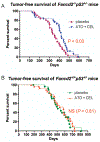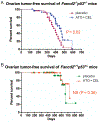Combination therapy with atorvastatin and celecoxib delays tumor formation in a Fanconi anemia mouse model
- PMID: 30255556
- PMCID: PMC6249055
- DOI: 10.1002/pbc.27460
Combination therapy with atorvastatin and celecoxib delays tumor formation in a Fanconi anemia mouse model
Abstract
Background: Fanconi anemia is an inherited bone marrow failure disorder associated with a high incidence of leukemia and solid tumors. Currently, no interventions to prevent or delay the formation of solid tumors are available.
Procedure: Two of the most important hallmarks of Fanconi anemia are inflammation and oxidative stress. In this study, we administrated the antioxidant atorvastatin and the anti-inflammatory drug celecoxib to cohorts of Fancd2-/- /Trp53+/- mice, a model of Fanconi anemia. Treatment started at weaning and continued until the mice developed a palpable mass or suffered from >20% weight loss. Tumor samples and selected tissues were subjected to histopathological examination. χ2 test was performed to analyze tumor incidence, and Kaplan-Meier survival curves were evaluated with log-rank test. In addition, a small cohort of mice was monitored for the safety of the drugs.
Results: The combined oral administration of both drugs significantly delayed tumor onset in Fancd2-/- /Trp53+/- mice. Specifically, the treatment delayed the onset of ovarian tumors in Fancd2-/- /Trp53+/- mice and increased the mean ovarian tumor-free survival time by 17%, whereas this combinatorial drug regimen did not have a significant effect on other tumor types. In addition, no detrimental effects on hematopoiesis from the drug treatment were observed during a 12-month safety monitoring.
Conclusions: The data presented here suggest that a combination of atorvastatin and celecoxib may be a good candidate for chemoprevention in Fanconi anemia.
Keywords: Fanconi anemia; ovarian cancer; tumor prevention.
© 2018 Wiley Periodicals, Inc.
Conflict of interest statement
Conflict-of-interest disclosure: The authors declare no competing financial interests.
Figures



Similar articles
-
Evaluation of resveratrol and N-acetylcysteine for cancer chemoprevention in a Fanconi anemia murine model.Pediatr Blood Cancer. 2014 Apr;61(4):740-2. doi: 10.1002/pbc.24780. Epub 2013 Sep 20. Pediatr Blood Cancer. 2014. PMID: 24115584 Free PMC article.
-
Heterozygosity for p53 (Trp53+/-) accelerates epithelial tumor formation in fanconi anemia complementation group D2 (Fancd2) knockout mice.Cancer Res. 2005 Jan 1;65(1):85-91. Cancer Res. 2005. PMID: 15665282
-
Metformin improves defective hematopoiesis and delays tumor formation in Fanconi anemia mice.Blood. 2016 Dec 15;128(24):2774-2784. doi: 10.1182/blood-2015-11-683490. Epub 2016 Oct 18. Blood. 2016. PMID: 27756748 Free PMC article.
-
Current knowledge on the pathophysiology of Fanconi anemia: from genes to phenotypes.Int J Hematol. 2001 Jul;74(1):33-41. doi: 10.1007/BF02982547. Int J Hematol. 2001. PMID: 11530803 Review.
-
[Fanconi anemia and DNA-damage response network].Tanpakushitsu Kakusan Koso. 2009 Mar;54(4 Suppl):580-5. Tanpakushitsu Kakusan Koso. 2009. PMID: 21089513 Review. Japanese. No abstract available.
Cited by
-
Advances in ovarian cancer treatment using a combination of statins with other drugs.Front Pharmacol. 2023 Jan 4;13:1048484. doi: 10.3389/fphar.2022.1048484. eCollection 2022. Front Pharmacol. 2023. PMID: 36686716 Free PMC article. Review.
-
Tongue cancer following hematopoietic cell transplantation for Fanconi anemia.Clin Oral Investig. 2022 Sep;26(9):5943-5952. doi: 10.1007/s00784-022-04554-2. Epub 2022 May 28. Clin Oral Investig. 2022. PMID: 35624384 Free PMC article.
References
-
- Rodriguez A, D’Andrea A. Fanconi anemia pathway. Curr Biol 2017:27(18):R986–r988. - PubMed
-
- Briot D, Mace-Aime G, Subra F, et al. Aberrant activation of stress-response pathways leads to TNF-alpha oversecretion in Fanconi anemia. Blood 2008:111(4):1913–1923. - PubMed
-
- Joenje H, Arwert F, Eriksson AW, et al. Oxygen-dependence of chromosomal aberrations in Fanconi’s anaemia. Nature 1981:290(5802):142–143. - PubMed
Publication types
MeSH terms
Substances
Grants and funding
LinkOut - more resources
Full Text Sources
Other Literature Sources
Research Materials
Miscellaneous

